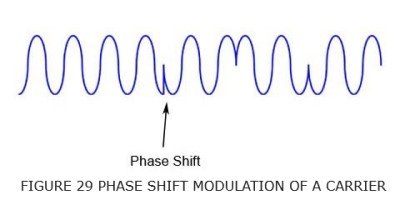Modulation means producing energy that is vibrating at a single pure frequency, called a carrier frequency or subcarrier, and changing aspects of it in discrete steps to represent bits.
The device that performs this function is called a modulator. A demodulator is required at the far end to interpret the carrier frequency and decide what bits it is representing at any given time. Clearly, we want devices to do both functions to implement two-way communications, so they are called modulator/demodulators or modems for short.
One aspect of the carrier than can be changed to represent bits is the volume or amplitude of the carrier: changing the amplitude of the carrier in discrete steps makes changes that represent bits.

Another aspect is the phase of the carrier: when the peak of the cycle is happening, in time, with respect to other carriers. Changing the time of the peak so it happens a bit earlier than others, or making it happen a bit later is making changes to the phase of the carrier that can represent bits (Figure 29).
Combinations of phase and amplitude shifting is called Quadrature Amplitude Modulation (QAM). QAM-64 means 64 possible different combinations of 8 different phases and 8 different amplitudes.
Each combination, also called a symbol or signal, is assigned a number. Binary numbers 6 bits long are required to give binary numbers to each of the 64 combinations.
7.3.2 Communicating Six Bits: Sending One of 64 QAM Signals
To communicate six bits in one fell swoop on a carrier, the transmitter generates electricity vibrating at the carrier frequency with the phase and amplitude corresponding to the combination indicated by the six-bit number.
The electricity is communicated on coaxial cables to Cable modems, on twisted pair to DSL modems, turned into radio by antennas for communication through space, or turned into light for communication in tubes of glass in very high capacity fiber transmission systems.
When the receiver detects energy at that single pure carrier frequency, it measures the phase and amplitude, and once it has decided, spits out the six-bit number of the combination it is hearing, and Bob’s your uncle.
7.3.3 Baud Rate
To get many bits per second, the procedure has to be repeated often!
Repeating it once per second yields 6 bits per second; the combination of phase and amplitude of the carrier is maintained for one second then changed to a different combination representing the next six bits.
The rate at which the procedure is repeated is called the baud rate, signaling rate and symbol rate.
The baud rate, how often a new combination can be applied to the carrier to communicate another 6 bits, is limited by interference called harmonics, where energy gets spread into adjacent frequencies, and interferes with communications on other carriers.
7.3.4 Orthogonal Frequency Division Multiplexing (OFDM)
When there are multiple carriers (called subcarriers) each running a modem, and the baud rate is the same as the subcarrier spacing, the harmonics from all subcarriers cancel out.
Eliminating this source of interference allows successful data transmission in parallel on closely spaced subcarriers.
This is a prime design characteristic of Orthogonal Frequency Division Multiplexing (OFDM), used on LTE, 5G, Wi-Fi, cable modems and DSL, and is the sweet spot for baud rate in terms of efficiency.
